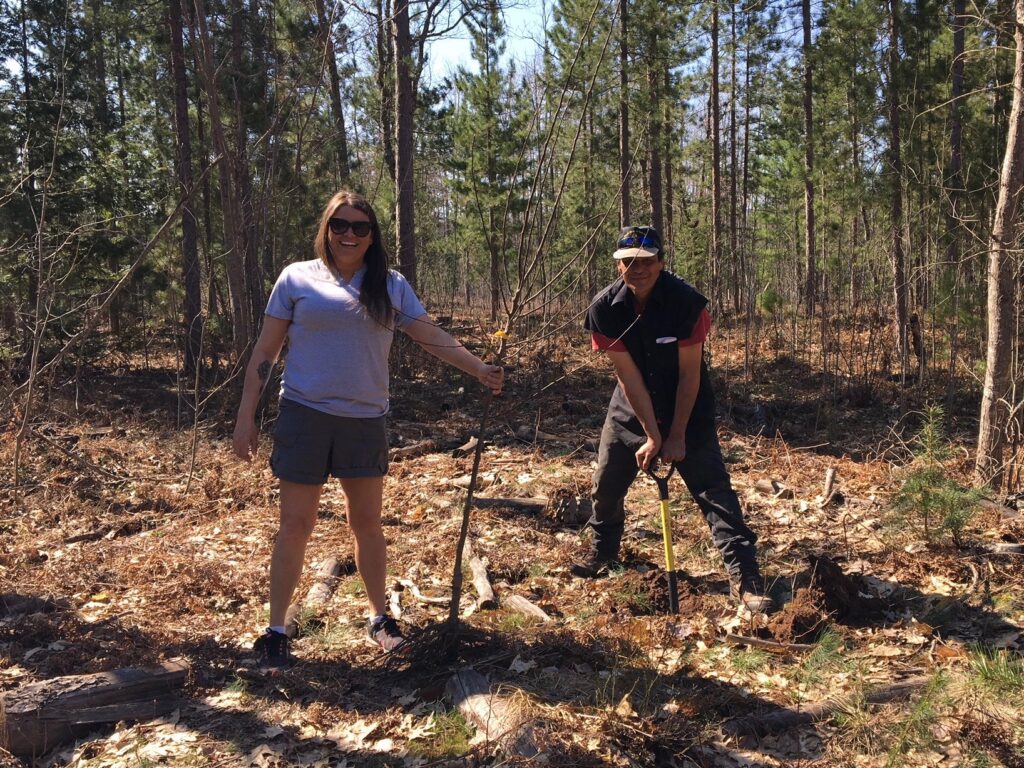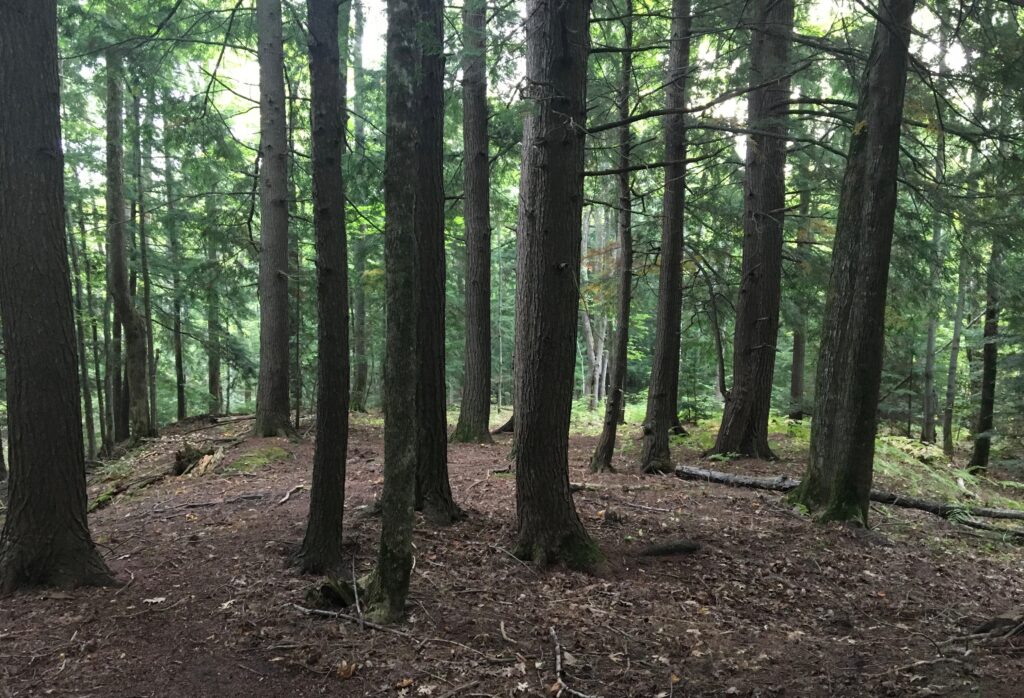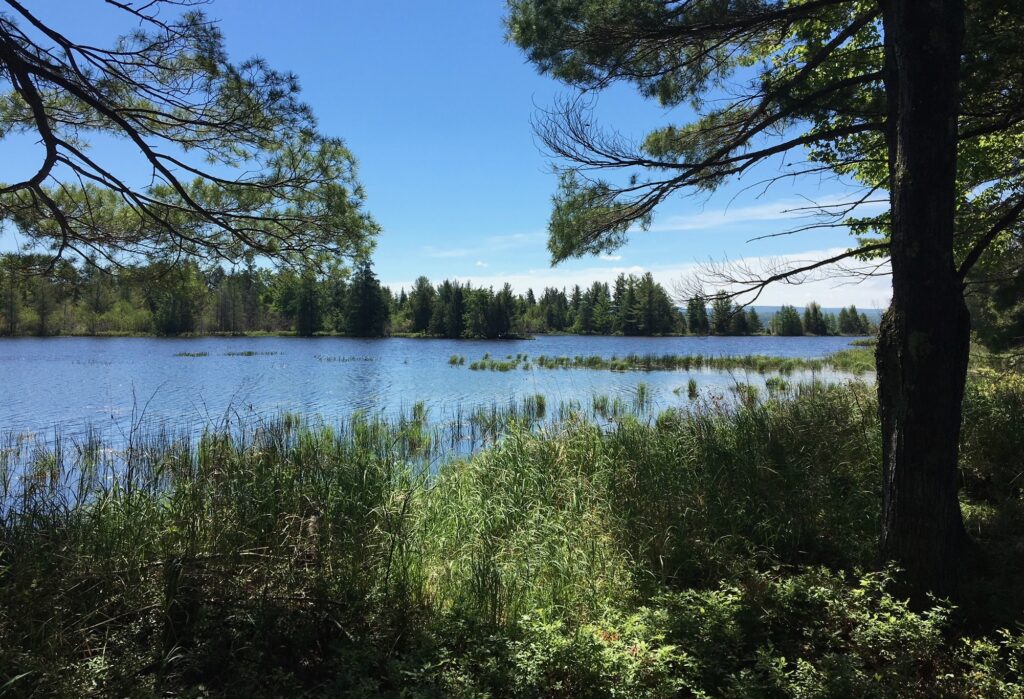Tribes were once criticized for failing to “develop” their land. Now their sustainably managed forests are generating income through the carbon market.
By Melanie Lenart

While economists see forest value unleashed by extracting timber or clearing the land for development, Native nations generally practice a more sustainable forest management. They value their forests as cultural and ecological sites that provide traditional plants and fuelwood while protecting wildlife and water.
Now this more sustainable approach is starting to pay off in dollars, as more tribal nations sign on to gain income from the growing carbon market.
This is not a get-rich-quick scheme, but real money is involved. The Keweenaw Bay Indian Community in northern Michigan, for example, is projected to receive about $12 million across 40 years–$300,000 a year—by enrolling 16,500 acres of its northern hardwood forest in a marketplace that allows businesses to offset their carbon footprint by investing in forest land.
Managing forests sustainably
“The tribe, their stance is they know how to steward their forests,” Tribal Forester Rachel Tarpey said. “If there can be revenue, if someone wants to compensate them for growing trees sustainably and sustainably living with their forests, then that’s great.”
After two years of paperwork, data collection and preparation that started in 2019, the project is finally ready to sell some of the carbon credits generated by the sustainable forest management. The Community serves the Keweenaw Bay Bands of Lake Superior Chippewa, known to themselves as Ojibwa Anishnabeg.
“They would like to keep this forested land forested and undeveloped,” said Tarpey, a longtime forester who has been working with the Keweenaw Bay Community for five years. “So the carbon program does that for the 40-year contract term.”
While Community members do harvest some trees in small-scale logging operations and for firewood, Tarpey said they do so to improve the forest, not clear-cut it. For instance, they may cut down some maple trees to promote the growth of the birch trees used for making traditional baskets, storage containers and canoes.
The reservation is mostly privately owned land, with a patchwork of different types of tribally owned or managed land, so forest management can be challenging and complicated. Tarpey said the carbon project includes “thousands” of parcels that average about 80 acres in size.
The extensive—and expensive—preparatory work would have prevented the tribe from participating in the carbon project, she said, if it weren’t for the support of the National Indian Carbon Coalition.
Nature-based solutions on tribal lands
Bryan Van Stippen directs the National Indian Carbon Coalition with a goal of creating a revenue source that can reward tribes for managing their forests, wetlands and grasslands so that they pull down more carbon dioxide.
“We’re looking specifically at nature-based solutions, which is ‘what are the natural resources that a tribal nation has possession over?’,” he said. “And then how do we enroll that into a protocol that makes sense for the tribe?”
If a tribal nation expresses an interest in participating, the coalition will cover the preparatory costs, he said, with the initial money paid back only once revenue starts rolling in. In the case of the Keewenaw Bay Indian Community, Van Stippen said Dick’s Sporting Goods is seeking to buy some of the carbon credits as part of a climate action goal to reduce its emissions.
The coalition prefers to work with the voluntary carbon market for several reasons, explained Van Stippen, who is a member of the Oneida Nation of Wisconsin. First, participating tribes don’t need to provide a limited waiver of sovereign immunity to participate, as they do in the more heavily regulated compliance market currently operating in California, which requires businesses to offset carbon if they don’t meet established emissions standards.
Also, projects tend to run for 40 years rather than the required 100 years for the compliance carbon market. Another benefit is that tribes can choose the buyers for their carbon credits, and thus avoid selling their carbon credits to businesses with unsustainable practices.
“I get questioned by oil and gas companies every day wanting to buy our credits,” Van Stippen said. He turns them down, as the tribal nations he represents have made clear that they are not interested in selling their credits to the companies extracting the fossil fuels driving climate change.
Fossil fuels like coal, oil and gas release carbon dioxide when used to run cars, factories and electricity plants. This carbon dioxide and other greenhouse gases thicken the atmosphere, allowing it to trap more heat.
Climate change and carbon
Carbon dioxide is the most prominent heat-trapping gas behind climate change, which starts with a rise in global temperature. As temperature rises, the world sees more extreme weather, such as severe droughts, floods and heat waves, as well as bigger wildfires, higher seas and stronger hurricanes.
As more businesses and countries turn to nature-based solutions to rein in climate change, the carbon market is projected to blossom into a $50 billion industry by about 2030.
Interior Secretary Deb Haaland emphasized the importance of nature-based solutions at the White House Leaders Summit on Climate in April of 2021 and during subsequent global climate talks. While reducing fossil fuel burning prevents future increases, forests and other natural systems actually reduce existing levels of heat-trapping carbon dioxide. (See Native Science Report’s story about the Summit here.)
Trees and other plants naturally extract carbon dioxide from the air, combining it with water to create the carbohydrates that form their leaves, roots and stems. They create their mass out of the carbon atom nestled alongside two oxygen atoms in a molecule of carbon dioxide. Once they’ve extracted that carbon, they release the oxygen.

This molecular action adds up to a powerful force globally, according to the world’s premier climate group, the Intergovernmental Panel on Climate Change. In the decade ending in 2019, forests and other land-based systems pulled down close to a third of the carbon dioxide released by the world’s people from burning fossil fuels and other practices, including large-scale deforestation.
About half of a tree’s dry weight comes from carbon that was formerly carbon dioxide. Scientists can measure the amount of carbon in various ecosystems and in the air, and use their measurements to assess how much carbon dioxide has been pulled down into the ecosystems.
A market for removing carbon dioxide
This is where the carbon market comes in. If a seller can prove to a third party registry that their management approach will increase the amount of carbon in a designated ecosystem, they can sell that carbon to companies who choose to support these projects to account for some of their own carbon dioxide releases. For instance, the American Carbon Registry, a third-party registry used on some of the coalition’s projects, assesses the increase by comparing tribes’ practices to other ways of managing the same type of land in the same region.
One “carbon credit” represents a metric ton of carbon, about 2,200 pounds. Prices fluctuate depending on demand. Van Stippen said the coalition guarantees at least $10 a metric ton, but has been receiving $15 in recent transactions.
The projects require data collection, including an initial on-the-ground survey of sample forested plots and follow-up surveys every five years. Van Stippen said he leans on his background as a lawyer to make sure any resulting data remains under the control of participating tribes.
“I want to make sure that the tribe retains all rights to any data or reports that are generated,” he said. He helps develop Memorandums of Understanding to ensure participating groups won’t publicly release information based on tribal data unless the tribal council in question approves.
While the coalition tends to focus on improved forest management, it recently ran an experimental project on Santa Ana Pueblo lands in New Mexico to determine if adding compost to grazed grasslands could help capture carbon dioxide.
“It’s pretty cool because if you go on Google Earth and you look at the Santa Ana Reservation, you can see the three one-acre test plots on which we dropped compost down, and how revitalized that land base is compared to the other surrounding grazing lands that they have there,” Van Stippen told participants of the National Tribal and Indigenous Climate Conference. (See our story about the conference here.)
Not everyone concerned about climate change supports the concept of the carbon market. Some worry that the registries aren’t independent enough, with their income linked to the sale of carbon credits. Others worry that polluters will avoid making other changes to reduce their emissions if they can buy carbon credits.
Even some members of a conservation group around Keweenaw Bay scoff at the concept of getting paid for sustainable forest management, Tarpey said. “A lot of them maybe don’t realize the cost of maintaining a large land base. There has to be revenue from somewhere to help support the cost of (managing) the land.”
Additional benefits of nature-based solutions
The carbon market promotes maintaining healthy forests to help pull down some of the heat-trapping gases that cause climate change. This type of management also helps the land and nearby communities adapt to climate change and the extremes that come with it.
For instance, most homes in the Keweenaw Bay Indian Community lack air-conditioning, so trees can provide life-saving cooling during heat waves. Forests and wetlands also purify water, an important service for an Ojibwa Community that continues its cultural tradition of subsistence fishing, including ice fishing. Forests also block winds and soak up water, services that become more valuable as storm severity ramps up with rising temperatures.
“We see a lot of resiliency for storms,” Tarpey said. “We’ve had more heavy rains and more winds with climate change. Forests are like the natural infrastructure for absorbing more water.”

The National Indian Carbon Coalition recently received a $1.1 million grant from the USDA’s Natural Resources Conservation Service to develop a tool for assessing the many co-benefits of protecting natural systems through the carbon market, Van Stippen said.
“We hope to be able to use those co-benefits as an additional revenue stream,” he said, “to keep these carbon projects going forward.”
Tribal nations that participate in the carbon market can use the money to manage land, create jobs, feed children, build homes, expand health services—or even to buy back some of their ancestral land. Van Stippen noted that the Yurok tribe of California used funds from the compliance carbon market to buy back some 60,000 acres of land.
Although the coalition was not involved in this project, he noted that a mission of the coalition’s parent organization, the Indian Land Tenure Foundation, involves reacquiring traditional lands.
“That’s the beauty to me for Indian Country is that we are the land owners. And we have a lot of land in which we can implement a lot of these practice changes and develop these carbon projects on,” Van Stippen said. “We have been successfully managing our lands for thousands of years. It’s been a long journey but I think we’re finally at the table.”
Melanie Lenart is a regular contributor to Native Science Report. Past positions include working for the University of Arizona’s Climate Assessment for the Southwest, and teaching global change biology, chemistry and other natural sciences at Tohono O’odham Community College.
Story published September 20, 2022
• • •
Enjoyed this story? Enter your email to receive notifications.
